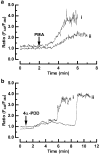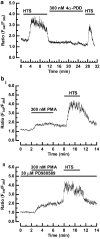Protein kinase C-mediated Ca2+ entry in HEK 293 cells transiently expressing human TRPV4
- PMID: 12970074
- PMCID: PMC1574039
- DOI: 10.1038/sj.bjp.0705443
Protein kinase C-mediated Ca2+ entry in HEK 293 cells transiently expressing human TRPV4
Abstract
1. We investigated whether protein kinase C (PKC) activation stimulates Ca2+ entry in HEK 293 cells transfected with human TRPV4 cDNA and loaded with fura-2. 2. Phorbol 12-myristate 13-acetate (PMA), a PKC-activating phorbol ester, increased the intracellular Ca2+ concentration ([Ca2+]i) in a dose-dependent manner, with an EC50 value of 11.7 nm. Exposure to a hypotonic solution (HTS) after PMA further increased [Ca2+]i. Two other PKC-activating phorbol esters, phorbol 12,13-didecanoate (PDD) and phorbol 12,13-dibutyrate, also caused [Ca2+]i to increase. 3. The inactive isomer 4alpha-PMA was less effective and the peak [Ca2+]i increase was significantly smaller than that induced by PMA. In contrast, 4alpha-PDD produced a monophasic or biphasic [Ca2+]i increase with a different latency, while 4alpha-phorbol had no effect. 4. The PMA-induced [Ca2+]i increase was abolished by prior exposure to bisindolylmaleimide (BIM), a PKC-specific inhibitor, and suppressed by the nonspecific PKC inhibitor 1-(5-isoquinolinesulphonyl)-2-methylpiperazine. The [Ca2+]i increase induced by 4alpha-PMA, 4alpha-PDD or HTS was not significantly affected by BIM. 5. These results suggest that both PKC-dependent and -independent mechanisms are involved in the phorbol ester-induced activation of TRPV4, and the PKC-independent pathway is predominant in HTS-induced Ca2+ entry.
Figures







Similar articles
-
Protein kinase C-dependent and -independent inhibition of Ca(2+) influx by phorbol ester in rat pancreatic beta-cells.Cell Signal. 2001 Mar;13(3):199-205. doi: 10.1016/s0898-6568(01)00136-x. Cell Signal. 2001. PMID: 11282458
-
Temperature-modulated diversity of TRPV4 channel gating: activation by physical stresses and phorbol ester derivatives through protein kinase C-dependent and -independent pathways.J Biol Chem. 2003 Jul 18;278(29):27129-37. doi: 10.1074/jbc.M302517200. Epub 2003 May 8. J Biol Chem. 2003. PMID: 12738791
-
Positive and negative inotropic effects of phorbol 12-myristate 13-acetate: relationship to PKC-dependence and changes in [Ca2+]i.J Mol Cell Cardiol. 1992 Sep;24(9):937-48. doi: 10.1016/0022-2828(92)91861-x. J Mol Cell Cardiol. 1992. PMID: 1433322
-
TRPV4 calcium entry channel: a paradigm for gating diversity.Am J Physiol Cell Physiol. 2004 Feb;286(2):C195-205. doi: 10.1152/ajpcell.00365.2003. Am J Physiol Cell Physiol. 2004. PMID: 14707014 Review.
-
[Phorbols: chemical synthesis and chemical biology].Yakugaku Zasshi. 2000 Jan;120(1):76-90. doi: 10.1248/yakushi1947.120.1_76. Yakugaku Zasshi. 2000. PMID: 10655784 Review. Japanese.
Cited by
-
Pannexin 1: a novel regulator of acute hypoxic pulmonary vasoconstriction.Cardiovasc Res. 2022 Aug 24;118(11):2535-2547. doi: 10.1093/cvr/cvab326. Cardiovasc Res. 2022. PMID: 34668529 Free PMC article.
-
Protein kinase C modulation of thermo-sensitive transient receptor potential channels: Implications for pain signaling.J Nat Sci Biol Med. 2011 Jan;2(1):13-25. doi: 10.4103/0976-9668.82311. J Nat Sci Biol Med. 2011. PMID: 22470230 Free PMC article.
-
ThermoTRP channels in nociceptors: taking a lead from capsaicin receptor TRPV1.Curr Neuropharmacol. 2008 Mar;6(1):21-38. doi: 10.2174/157015908783769680. Curr Neuropharmacol. 2008. PMID: 19305786 Free PMC article.
-
Pathophysiological Roles of the TRPV4 Channel in the Heart.Cells. 2023 Jun 17;12(12):1654. doi: 10.3390/cells12121654. Cells. 2023. PMID: 37371124 Free PMC article. Review.
-
The thermo-TRP ion channel family: properties and therapeutic implications.Br J Pharmacol. 2012 Feb;165(4):787-801. doi: 10.1111/j.1476-5381.2011.01601.x. Br J Pharmacol. 2012. PMID: 21797839 Free PMC article. Review.
References
-
- BRAKEMEIER S., EICHLER I., HOPP H., KOHLER R., HOYER J. Up-regulation of endothelial stretch-activated cation channels by fluid shear stress. Cardiovasc. Res. 2002;53:209–218. - PubMed
-
- CHEN Y., SIMASKO S.M., NIGGEL J., SIGURDSON W.J., SACHS F. Ca2+ uptake in GH3 cells during hypotonic swelling: the sensory role of stretch-activated ion channels. Am. J. Physiol. 1996;270:C1790–C1798. - PubMed
-
- CHENG J.-J., WUNG B.-S., CHAO Y.-J., WANG D.L. Sequential activation of protein kinase C (PKC)-α and PKC-ɛ contributes to sustained Raf/ERK1/2 activation in endothelial cells under mechanical strain. J. Biol. Chem. 2001;276:31368–31375. - PubMed
-
- DELANY N.S., HURLE M., FACER P., ALNADAF T., PLUMPTON C., KINGHORN I., SEE C.G., COSTIGAN M., ANAND P., WOOLF C.J., CROWTHER D., SANSEAU P., TATE S.N. Identification and characterization of a novel human vanilloid receptor-like protein, VRL-2. Physiol. Genomics. 2001;4:165–174. - PubMed
Publication types
MeSH terms
Substances
LinkOut - more resources
Full Text Sources
Other Literature Sources
Molecular Biology Databases
Miscellaneous

